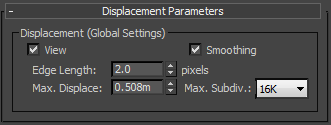Contains controls for displacement and height (normal bump) mapping.
Interface

Displacement (Global Settings) group
- View
- Defines the space for displacement. When View is on, the Edge Length specifies the length in pixels. When off, the Edge Length is specified in world space units. Default=on.
- Smoothing
- Turn off to have the iray renderer correctly render height maps. Height maps can be generated by Normal Bump mapping.
When using only height maps in the scene, make sure this option is off. If some objects in the scene use height maps while others use standard displacement, apply smoothing on a per-object basis.
When on, the iray renderer simply smoothes the geometry using the interpolated normals, making the geometry look better. This result, however, cannot be used for height map displacement because smoothing affects geometry in a way that is incompatible with height mapping.
- Edge Length
- Defines the smallest potential edge length due to subdivision. The iray renderer stops subdividing an edge once it reaches this size. Default=2.0 pixels.
- Max. Displace
- Controls the maximum offset, in world units, that can be given to a vertex when displacing it. This value can affect the bounding box of an object. Default=0.508m (meters). Tip: If displaced geometry appears to be “clipped,” try increasing the value of Maximum Displace.
- Max. Subdiv.
- Controls the extent to which the iray renderer can recursively subdivide each original mesh triangle for displacement. Each subdivision recursion potentially divides a single face into four smaller faces. Choose the value from the drop-down list. Range=4 to 64K (65,536). Default=16K (16,384).
For example, using the default value means that the iray renderer can subdivide each displaced mesh triangle into as many as 16,384 smaller triangles.